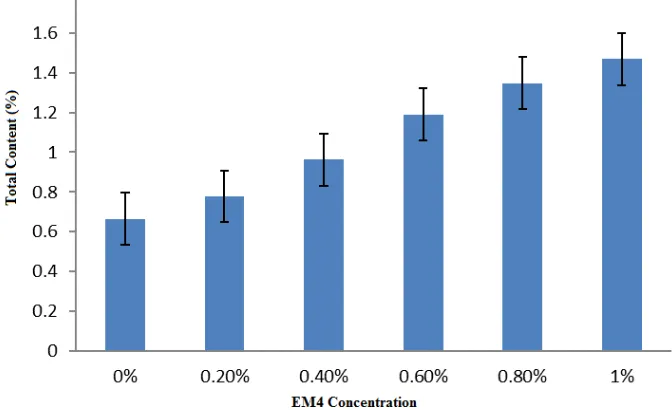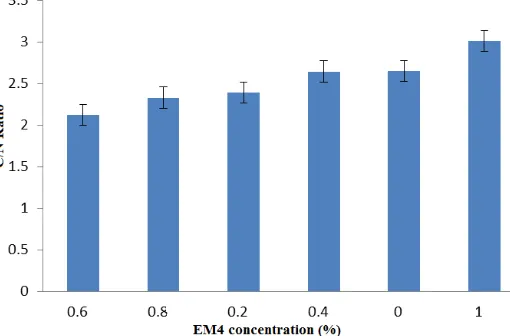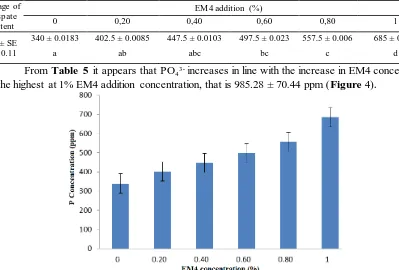Productive Liquid Fertilizer from Liquid Waste Tempe Industry
as Revealed by Various EM4 Concentration
Sri Hartini1, Fred Letsoin2, A. Ign. Kristijanto3 1,2,3Satya Wacana Christian University, Salatiga, Indonesia
Email: sri.hartini@staff.uksw.edu
Abstract. Recently, using of productive liquid fertilizer assumed as a proper and practical
fertilizer for plant productivity purposes. Various ways of enrichment of liquid fertilizer is done to achieve certain quality. The purpose of this research was to determine the proper additional formulation in the process of making productive liquid fertilizer based on the various concentration of EM4 as well as comparated the result with SNI. Liquid tempe waste were collected from some tempe industries at Sidorejo Kidul village, Tingkir district, Salatiga. The concentration of EM4 which were added to the tempe wastewater are 0%; 0.20%; 0.40%; 0.60%; 0.80%; 1.00% respectively. The pH, temperature, C total, N total, C/N ratio, and PO4
3-were measured. Data was analyzed by using Randomize Completely Block Design (RCBD) with 6 treatments and 4 replications. Comparison between the average, the Honestly Significance Deference (HSD) 5% was used. The results showed that the addition of EM4
indicated there were a significant progress. Moreover, the most effectiveformula to increase the quality of productive liquid fertilizer from liquid waste tempe was found in addition of 1.00% EM4 with the gained analysis value for the C total, N total, C/N ratio, and degree of PO43- as follows : 4.395 ± 1.034%; 1.470 ± 0.081%; 3.01 ± 0.756; 685.28 ± 70.44 ppm .
Associated with the need fulfillment of SNI hence can be concluded that result of Productive Liquid Fertilizer (PLF) from liquid waste tempe successfully fulfill SNI of liquid fertilizer for pH parameter and total N, only.
Key words : EM4, liquid tempe wa ste, productive liquid fertilizer
1.Introduction
Tempe is one of traditional fermented foods of Indonesia that has been knew globally [1]. Tempe is consumed practically all over Indonesia, although the consumption level still varies from one province to another. As a result of the many tempe industries, the waste production process bring an impact on the environment. According to [2], waste obtained from byproducts of tempe making, if not properly managed and only directly discharged into the waters will greatly disrupt the surrounding environment because it can damage the quality of groundwater, causing unpleasant odor, and trigger the growth of various bacteria Pathogens.
foliar liquid fertilizers containing essential macro and micro nutrients such as N, P, K, S, Ca, Mg, B, Mo, Cu, Fe, Mn and organic materials [3]. Liquid organic fertilizer beside improving the physical, chemical and biological properties of the soil, can also help increase crop production and reduce the use of inorganic fertilizers and useful as an alternative to manure [4].
Productive Liquid Fertilizer (PLF).
Productive liquid fertilizer is a fertilizer derived from animals or plants that have undergone fermentation [5]. In the process of fermentation, organic compounds break down into simpler compounds such as sugar, glycerol, fatty acids and amino acids. Decomposition of organic compounds or decomposition can be done with the addition of a starter. The specialty of this organic fertilizer is that it can quickly overcome nutrient deficiencies, has no problem in nutrient leaching and is able to provide nutrients quickly compared to inorganic fertilizers. Liquid fertilizers generally do not damage the soil and plants, although used as often as possible. In addition, this fertilizer also has a binder, so that the solution of fertilizer given to the soil surface can be directly used by plants [6].
Effective Microorganism 4 (EM4).
EM4 (Effective Microorganism 4) technology is a fermentation technology that uses a mixed culture of several microorganisms that the fermentation product is beneficial for plant growth. The natural fermentative microorganisms in EM4 consist of five groups of microorganisms, namely photosynthetic bacteria (Rhodopseudomona s sp.), Fermented fungi (Sa ccha romyces sp.), Lactic acid bacteria (Lactobacillus sp.), and Actinomycetes [7].
EM4 is useful to help speed up the process of making organic fertilizers and improve its quality. In addition, EM4 is also useful to improve soil structure and texture to be better and supply the nutrients needed by plants. Thus, the use of EM4 can make plants more fertile, healthy and relatively resistant to pests and diseases [6]. The organic matter is a food and energy source [7].
The purpose of this research was to determine the proper additional formulation in the process of making productive liquid fertilizer based on the various concentration of EM4 as well as comparated
the result with SNI.
2.Mate rial and me thod 2.1. Material.
Samples are wastewater from soaking water soybean which were taken from 4 tempe craftsmen in Sidorejo Kidul Subdistrict, Salatiga. Chemicals used aquadest, Potassium Dichromate (K2Cr2O7) 1 N,
0.5% aqueous Barium Chloride (BaCl2) solution, concentrated sulfuric acid (H2SO4), Hydrochloric
acid (HCl) 0.05 N, raw sacharose, PhosVer 3 Phosphate reagents, as well as Potassium 1, 2, and 3 reagents.
2.2. Method.
2.2.1. Measuring on pH [9] and Temperature [10].
The pH value measurements were done using pH-meter on the liquid waste sample (as control) and the PLF product of various concentrations, while for temperature measured using a thermometer. Incubation time was performed during 1 week.
2.2.2. Total C Analysis [11]
Total C analysis is done by Walkley & Black method. It had performed on Laboratory of Agriculture Faculty-Satya Wacana Christian University.
2.2.3. Total N Analysis [12]
2.2.4. PO43- Analysis [13]
25 ml of sample and aquadest, each put into 2 pieces of cuvette. The first cuvette is blank while the
second quvet is the sample. The spectrophotometer is then set to program 490 with a wavelength (λ) of
890 nm. The second cuvette plus 1 PhosVer 3 Phosphate reagent. After the reagent is added to the sample, the timer on the spectrophotometer is then activated. After the time on the timer is exhausted (2 minutes), the cuvette contains the blanks inserted in the spectrophotometer to zero the value on the LCD spectrophotometer screen, then the sample measured its phosphate content using a spectrophotometer.
2.2.5. Productive Liquid Fertilizer (PLF) Making.
Samples of 4 united tempe craftsmen (750 mL from each craftsman) were boiled first until boiling, after a cold sample, divided into 6 glass beaker 500 mL. Each beaker added EM4 with 0% concentration; 0.2%; 0.4%; 0.6%; 0.8%; 1%. After that closed for 1 week. Measurements were made for the total C and N parameters, C / N, P and K ratio after being PLF.
2.2.6. Data Analysis [8].
The research data were analyzed using Randomized Block Design (RBD) with 6 treatments and 4 replications. As the treatment is a variation of the addition of EM4 concentration into PLF, and the group is the time of analysis. Differences between treatment intervals were tested with Honesty Significant Different (HSD) with 5% significance level.
3.Re s ult And Dis cussion
3.1. Temperature and pH between different concentrations of EM4 additions
The average temperature between the various concentrations of EM4 additions ranged from
25°C to 25.5 ± 0.29°C, while the pH ranged from 4.05 ± 0.0289 to 4.375 ± 0.0946 (Table 1).
Table 1. Temperature value and pH between different concentrations of em4 addition EM4 addition (%)
Table 1 shows that the addition of various EM4 concentrations has no effect on temperature or pH. Standard pH of liquid fertilizer according to SNI between 4 - 9, so that the pH value obtained in this study has fulfilled the requirements of liquid fertilizer.
3.2. Total C (%) between different concentrations of EM4 additions
The total average C between the various concentrations of EM4 additions ranged from 1.393 ± 0.427% to 4.395 ± 1.034% (Table 2).
- T he numbers followed by the same letters show that the treatments are not significantly different, while the numbers followed by the unequal letters show between the different treatments significantly. This description also applies to Tables 3, 4 and 5.
Table 2 shows that total C did not increase until addition of EM4 concentration 0.4% and tends to start increasing in addition of EM4 concentration 0.6% and 0.8%. The highest total C was obtained at the addition of EM4 concentration of 1%, i.e. 4.395± 1.034% (Fig. 1).
Figure 1. Bar diagram of total C amount of different concentrations of EM4 addition
Figure 1 shows that the addition of EM4 concentration increases the total C content, this is related to the EM4 fluid that has been found as a source of carbon in the form of molasses which is useful as a reservoir of C container contained in the EM4. Despite the increase, the total amount of C obtained is still far below the standard of liquid fertilizer quality (SNI total C of liquid fertilizer ranges between 9.8 - 32%).
3.3. Total N between different concentrations of EM4 additions
Average total N content between different concentrations of addition EM4 ranging from 0% to 1% (Table 3).
Table 3. Average total N content between different concentrations of addition EM4 EM4 addition (%)
0 0.20 0.40 0.60 0.80 1
X ± SE 0.665±0.158 0.788± 0.163 0.963± 0.195 1.190± 0.103 1.348± 0.096 1.470±0.081
W = 0,31 a a a b b b
Figure 2. Bar diagram of total N between different concentrations of EM4 additions
The same increase in total N in the addition of EM4 concentration of 0.6% -1%, (Fig. 2) is associated with the increasing amount of EM4 volume added, the amount of microbial composition of the organic material increases as well, resulting in total inorganic N (NH4+ and NO3-) As the result of
decomposition of organic material (protein) will increase also [14]. The total N total that produced have fulfilled SNI quality standard. SNI quality standard for liquid fertilizer is > 0.2%.
3.4. C / N Ratio Between Addition of EM4 Different Concentrations
The average C / N (X ± SE) ratio between the different concentrations of EM4 additions is the same and ranges from 2.123 ± 1.004 up to 3.010 ± 0.756 (Table 4).
Table 4. C / N Ratio (X ± SE) between different concentrations of EM4 additions (%)
EM 4 Additions(%)
0.60 0.80 0.20 0.40 0 1
X± SE
2.123 ± 1.004 2.33 ± 0.718 2.39 ± 0.570 2.644 ± 0.335 2.65 ± 0.362 3.01 ± 0.756
W = 2.841 a a a a a a
From Table 4, it is seen that the C / N ratio is the same among the various concentrations of EM4 addition (Figure 3).
Based on the research data, it is found that the C/N ratio of PLF of tempe liquid waste tested
is still far below SNI 19-7030-2004 standard. SNI standard for C/N ratio ranges from 11 to 20.
Research conducted in a C/N ratio of 1.71-3.73 with the addition of EM4 of 1%. The low C / N ratio
due to the fermentation of tempe liquid waste has a low C organic content resulting in a low C / N
ratio as well. This occurs because no additional carbon source is added to the fermentation of liquid
tempe fertilizer, so the growth of microorganisms is hampered because it does not have enough energy
source [5].
3.5. Phosphate level between different concentrations of EM4 addition
Average of PO43- levels between various concentrations of EM4 addition ranged from 340 ±
0.0183 ppm to 685 ± 0.044 ppm (Table 5).
Table 5. Average of Phosphate Content between different concentrations of addition EM4
Average of Phospate
Content
EM 4 addition (%)
0 0,20 0,40 0,60 0,80 1
X ± SE 340 ± 0.0183 402.5 ± 0.0085 447.5 ± 0.0103 497.5 ± 0.023 557.5 ± 0.006 685 ± 0.044
W = 0.11 a ab abc bc c d
From Table 5 it appears that PO43- increases in line with the increase in EM4 concentration
and the highest at 1% EM4 addition concentration, that is 985.28 ± 70.44 ppm (Figure 4)
.
Figure 4. Bar chart of phosphate content between PLF with various concentrations of EM4 addition
The SNI content of PO43- for organic liquid fertilizer is > 1000 ppm. The highest PO43- level
obtained from this study was 685.28 ± 70.44 ppm on the addition of EM4 1%, so PO43- levels have
not met the SNI requirements. The low phosphate content obtained is related to its presence in tempe waste in the form of phytic acid which is difficult to dissolve in water so it can not be overhauled by microbes present in EM4.
4. Conclusions
The result of Liquid Productive Fertilizer (LPF) from tempe liquid waste successfully fulfill SNI of liquid fertilizer for pH parameter and total N.
References
[1] Nurdini, A. L., Nuraida L., Suwanto A. and Suliantari. 2015. Microbial growth dynamics during tempe fermentation in two different home industries. International Food Research Journal 22(4): 1668-1674. Journal homepage: http://www.ifrj.upm.edu.my
[2] Wiryani, E. 2009. Analisis Kandungan Limbah Cair Pabrik Tempe. eprints.undip.ac.id/2121/ [3] Lestari, B. I. (2005). Studi Pembuatan Briket Bioarang dari Sekam Padi dengan Proses Karbonisasi
Menggunakan Tungku Sederhana. Laporan Tugas Akhir Jurusan Teknik Lingkungan FTSP– ITS. Surabaya.
[4] Parman, S., 2007. Pengaruh Pemberian Pupuk Organik Cair Terhadap Pertumbuhan dan Produksi Kentang (Sola num tuberosum).Buletin Anatomi da n Fisiologi, Vol XV: 21-31.
[5] Caseria, R. Y., Ruslan W. and Bambang S., 2014. Pengaruh penggunaan Starter Terhadap kualitas Fermentasi limbah cair tapioka sebagai alternatif pupuk Cair. Jurnal Sumberdaya Alam dan Lingkungan. jsa l.ub.a c.id/index.php/jsal/a rticle/viewFile/122/104.
[6] Hadisuwito, S., 2007. Membuat Pupuk Kompos Cair. Jakarta: Agro Media.
[7] Fitria, Y., 2008. Pembuatan Pupuk Organik Cair dari Limbah Cair Industri Perikanan
Menggunakan Asam Asetat dan EM4 (Effective Microorganism 4). Skripsi. Bogor : Institut Pertanian Bogor.
[8] Steel R G D, Torrie J H. Principles and Procedures of Statistic Biometrical Approach. 2nd. Japan. Mc Graw Hill International Book co, 1981, p.633.
[9] SNI, 2004. Air dan air limbah-Bagian 11 : Cara uji derajad keasaman (pH) dengan menggunakan alat pH meter. SNI 06-6989.11-2004.
[10] SNI, 2005. Air dan air limbah-Bagian 23 : Cara uji suhu dengan termometer. SNI 06-6989.23-2005
[11] Wang, X., Jiaping W. and Juan Z., 2012.
Comparisons of Three Methods for Organic and
Inorganic Carbon in Calcareous Soils of Northwestern China. PLoS One. 2012; 7(8):
e44334.
[12] Wang H., Pampati N., McCormick W. M. and Bhattacharyya L., 2016. Protein Nitrogen Determination by Kjeldahl Digestion and Ion Chromatography. J Pharm Sci. 2016 Jun;105(6):1851-1857. doi: 10.1016/j.xphs.2016.03.039.
[13] HACH DR 2000. Analytical Procedures for HACH DR/2000 and DR/3000 Instrument.
[14] Megawati and Aji, K. W. 2014. Pengaruh Penambahan EM4 (Effective Microorganism-4) Pada Pembuatan Biogas dari Eceng Gondok dan Rumen Sapi. Jurnal Bahan Alam Terbarukan. ISSN 2303-0623.



